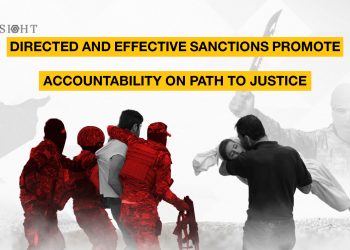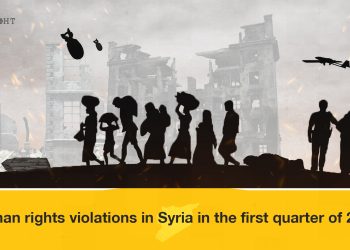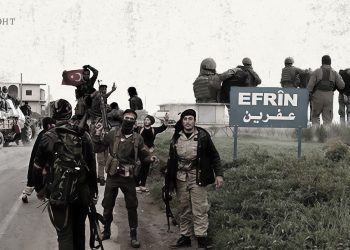Introduction
This report sheds light on ongoing human rights violations after 13 years of conflict in Syria.
Documentation and data collected by Insight shows that extrajudicial killings, injuries, and arrests perpetrated by parties to the conflict continue despite the decline in the number of direct military clashes, and that the crimes of torture, rape, enforced disappearance, and seizure of property cause further tragedies in Syria.
Conditions for Syrians have become extremely difficult. Continuous violations threaten the very lives and safety of civilians, in addition to economic deterioration and obstacles to the right to free movement, health, and basic services like as shelter, food and clean water.
To prepare this report, Insight’s monitoring team consulted open sources, contacted field sources, activists and legal experts, collected data on individual violations, and consulted reports and appeals from other local organizations. The data verification started from the beginning of January 2024 and lasted until mid-July.
The parties committed the following violations include all of the influential actors in the country: the Syrian government and their supporters, the Iranian and Russian forces and Lebanese Hezbollah, Hayat Tahrir al-Sham (formerly Jabhat al-Nusra) and the jihadists in Idlib, Syrian National Army factions and their backer, Turkey, the Syrian Democratic Forces and the Global Coalition, ISIS cells, and other armed groups.
We believe that the number of victims is greater than the statistics revealed in this report. These monitored and verified cases prove that these violations continue to occur in different places across the country.
Insight considers the numbers showed in this report to be an appeal to the parties responsible for the violations, and those responsible for documenting them, to curb the continuous hostilities, crimes, violations, and freedom restrictions.
Parties to the conflict should state their obligations upon signing international conventions, join civil efforts to document violations, and use to transparent legal means to hold perpetrators accountable and to bring justice to the victims, survivors and their families.
The General Statistics of Victims in Syria
The parties to the conflict in Syria and intervening external forces continue to commit human rights violations more than 13 years after the 2011 protests and subsequent conflict between government forces and their opponents, as well as foreign military interventions.
Still, there are many barriers to the collection and preservation of evidence of violations and to effective sharing of information to facilitate and expedite accountability procedures.
During the first half of 2024, there were at least 2632 casualties on Syrian territory. 1,448 people were killed and 1,184 were injured.
1,129 Syrian civilians became victims of the conflict and violations in the country, amidst continuous indiscriminate attacks, the absence of accountability, and impunity. 520 were killed and 609 were injured.
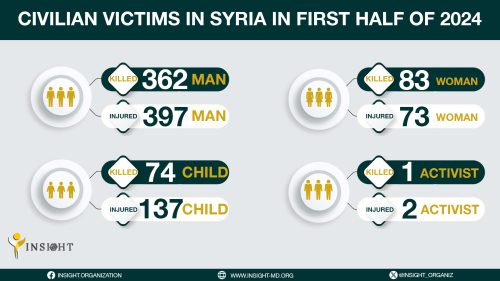
According to ‘Insight’, in the first half of 2024, 1,412 military personnel were victims of the conflict. 839 were killed and 573 were injured.
The military personnel were killed and injured by shooting or explosive devices, mutual shelling between the conflicting parties, war remnants and mines, and in ISIS attacks.

89 ISIS members or individuals accused of dealing with its cells were killed. 2 were injured.
Causes of Civilian Casualties
Although no change has happened in influential areas in the first half of 2024, clashes broke out and parties to the conflict carried out security and military operations, suppressed protests, and imprisoned, tortured and assaulted innocent people.
Most civilian casualties occurred by means of direct targeting with weapons.
Direct targeting with weapons caused the killing of 203 civilians and injury of 132 others. One civilian victim was a protestor in Suwayda, where protests against the Syrian government continue.
Artillery and aerial shelling killed 64 civilians and injured 194.
Besides Syrian, Turkish, Russian and Israeli shelling, Jordan targeted sites in Suwayda with airstrikes, claiming that the sites belonged to drug dealers. However, the strikes caused civilian casualties.
Military clashes between conflicting parties or within individual factions themselves caused the death of 21 civilians and the injury of 17 others.
ISIS attacks killed 26 civilians and injured 6 people.
The explosion of war remnants killed 107 civilians injured 88 others.
Incidents of assault by beating or other methods of violence outside of detention centers caused the killing of 32 civilians and 92 others. The team at Insight was able to verify the rape of a girl in Sherawa district in Afrin.
Torture within prisons and detention centers caused the death of 11 civilians. 4 civilians were killed in field executions.
33 civilians were killed and 51 others were injured in tribal fighting.
Explosive devices that targeted places and people killed 16 civilians and injured 27 others.
1 civilian was killed and another one was injured after being intentionally run over by a vehicle.
2 civilians died by drowning, as the Turkish gendarmerie threw them into al-Assi river.


Arbitrary Detention
Since the 2011 protests, arbitrary detentions were the gateway to the most serious crimes under international law, like killing, torture, rape, and enforced disappearance.
Hostility, hatred and abuses to retaliate against adversaries and opponents and put pressure on other parties have become features of those with influence inside Syria after 13 years of conflict, which has produced many security and military actors that now have access to more dangerous and secret prisons.
Insight recorded the arbitrary detention of 1,494 persons in Syria, during the first half of 2024. This indicates that the conflicting parties continue to perpetrate torture and enforced disappearances.
Hayat Tahrir al-Sham perpetrated the highest rate of arbitrary detentions, exceeding 37% of all arrests with 558 persons (34 military personnel and 524 civilians).
The arrests campaign of HTS against its own members have escalated since mid-2023. These campaigns have extended to civilians, particularly as protests have increased calling for the release of former detainees.
The charges against the civilians repeated in most detentions. These were: incitement against HTS, dealing with hostile actors, and participating in protests against its practices.
The military detainees were accused of espionage for government and Russian forces, while some faced charges of participating in operations that targeted HTS members.
In regions under the control of the Turkey-backed Syrian National Army region, 281 people were detained: 4 military personnel and 277 civilians.
The authorities of the National Army have charged civilian detainees with dealing with hostile actors and refraining from paying fines and fees imposed by factions. In Afrin, Ras al-Ayn and Tal Abyad, a common charge was participating in the former Autonomous Administration. They impose fines according to the previous job mentioned in the charge.
Testimonies documented by Insight confirm that these are malicious charges and are sometimes aimed at obtaining ransoms, especially against the elderly.[1]

Turkish forces detained 215 persons — 3 military personnel and 212 civilians — on charges of dealing with the SDF, threatening Turkey’s national security, and attempting to cross the Syrian-Turkish border by irregular means.
The number of persons transferred to Turkish prisons accused of belonging to or dealing with the SDF was 130 who were detained in previous periods. These included 2 military personnel and 128 civilians, including 27 women and 3 children.
In SDF-held areas, the authorities detained 233 people accused of belonging to ISIS or helping its members to escape from al-Hawl camp.
Insight monitored arbitrary detentions by several actors in government-held areas. 207 persons were detained, including 116 members of armed forces and 91 civilians.
Pro-Iranian and Hezbollah groups arrested 110 individuals, including 100 military personnel within their factions and 10 civilians, on charges of espionage and assisting hostile attacks.
Security agents of the Syrian government arrested 79 persons, including 75 civilians and 4 military personnel, on charges of speaking up against the government or other security reasons, such as presence in sites that were later attacked or crossing the Lebanese border by irregular methods.
Local groups in south Syria arrested 12 members of the Syrian government forces in Suwayda to push the government to release their detainees. They also arrested 2 men in Daraa to push a person accused of drug dealing to surrender himself.
Jordan arrested 4 fishermen, claiming that they had crossed from the Syrian side of the Yarmouk River.

ISIS
Since the end of ISIS control in its last stronghold in Baghouz, eastern Syria, in 2019, it continues to attempt to impose control and carry out attacks in northeastern region, the Syrian desert, and southern regions.
ISIS cells carried out attacks against militaries and civilians. The most prominent were against truffle hunters. They also laid mines and explosive devices on the roads.
In comparison to the first half of 2023, ISIS attacks in first half of 2024 increased by 5%. ISIS members carried out at least 140 attacks, they claimed 78 of the attacks via online IDs.
ISIS attacks and the explosion of war remnants planted by its armed men caused the casualties of 639 persons, of whom 346 were killed and 293 were injured.
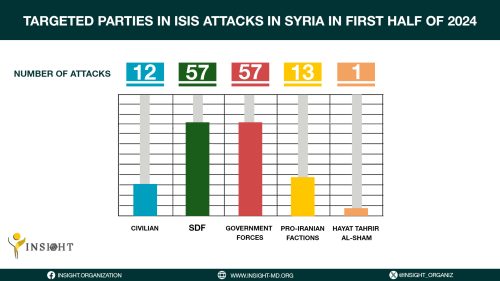
One of the areas most attacked by ISIS was Deir ez-Zor, where the group launched 77 attacks, followed by Homs, with 40 of attacks, and Hasakah, with 8 attacks.
The distribution of attacks over the months indicates a decrease in the second quarter of the year compared with the first quarter.

In these attacks, the gunmen killed 293 persons (26 civilians and 267 military personnel) and injured 238 persons (6 civilians and 232 military personnel).

Among those victims, 7 men were killed and 1 man and 1 woman were injured. All of these individuals were truffle hunters, who were targeted repeatedly this year.
Besides the casualties caused by the attacks, mine and war remnants explosions killed 53 military personnel and injured 55 others.
On the other hand, the parties to the conflict in Syria launched 34 security operations against ISIS, that in which 98 ISIS members were killed.

Al-Hawl camp
Mass exits from Al-Hawl camp, northeastern Syria, towards Syrian and Iraqi areas for reintegration with original communities, as well as the handover of foreign nationals to their State delegations, resulted in the departure of 4,281 individuals, mostly women and children, from the camp.
In 2023, al-Hawl camp had 45,355 persons, including 21,633 Iraqi men and women, 17,002 Syrian men and women, and 6,720 other nationalities, mostly the wives and children of ISIS members.
The number has decreased to be 41,074 in June, including 18,160 Iraqi men and women, 16,503 Syrian men and women, and 6,411 of other nationalities.

Foreign women and children were handed over to official delegations of the United States, the Netherlands, Canada, Finland, Russia, the United Kingdom, Tajikistan and Kyrgyzstan.
Violations by Foreign Forces in Syria
The conflict in Syria and the emergence of ISIS led several states to intervene in the country and provide support to parties to the conflict, most notably Turkey, Russia, the United States and Iran, in addition to repeated Israeli shelling.
Military actions by foreign state forces in the Syrian conflict killed 253 civilians and military personnel and injured 229 others.
Turkey
In the first half of 2024, Turkish forces violated human rights and international humanitarian law in Syria through indiscriminate attacks on northeast Syria and attacks on asylum seekers.
The Turkish forces caused 187 civilian casualties: 45 killed and 142 injured.
The number of civilian victims was 148: 24 killed and 124 injured.

Turkish forces killed 7 civilians, including 1 woman and 1 child, and injured 45 civilians, including 8 women and 16 children.
Turkish border guards directly targeted asylum seekers, killing 12 civilians, including 1 woman, and injuring 36 civilians, including 4 women and 1 child, while they attempted to cross the Syrian-Turkish border.
Border guards’ attacks on those who attempted to cross the Syrian-Turkish border killed 2 men and injured 42 civilians (33 men, 7 women and 2 children).
Turkish forces also killed 1 man and injured 1 woman by running over them with vehicles. They also killed 1 man and 1 child by throwing them into al-Assi river.
In the first half of 2024, the number of military casualties by Turkish attacks was 39. 17 SDF military personnel were killed and 8 were injured. 4 government personnel were killed and 10 were injured.
The Turkish army shelled 351 sites in north Syria, of which 72% were in residential areas.

Turkey escalated its shelling during January (171 sites) and May (99 sites).
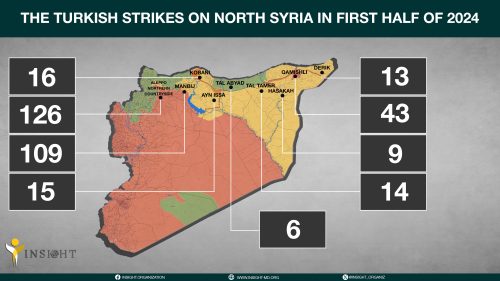
Among the Turkish strikes, Insight monitored 80 attacks by drone and 8 by warplane.
At the end of 2023 and beginning of 2024, the Turkish attacks destroyed sources of oil, electric power and household gas in the Autonomous Administration’s region, causing problems in the availability of fuel and electricity.[2]
Public power outages in Qamishli and other areas continued until after mid-year.
During 2024, Turkey continued to build housing units to accommodate displaced people from other areas of Syria and to settle the families of opposition militants in Afrin, which caused control of public property and accelerated demographic change in Afrin and its surroundings in the northern countryside of Aleppo.
The number of housing blocks monitored by Insight was 11. 1 was built with Palestinian support, 2 with support from organizations based in Britain, and the rest with Turkish support.
Iran
Shelling by pro-Iranian groups on HTS’s influence areas in northwest Syria and on the SDF in northeast Syria caused the killing of 11 people: 10 military personnel and 1 civilian.
Five members were killed in internal fighting between pro-Iranian groups.
Iranian forces killed 9 civilians, including one child, through direct targeting with weapons.
Pro-Iranian groups and Hezbollah arrested 110 persons — 100 of their own military personnel and 10 civilians — on charges of espionage and assisting in hostile attacks.
Russia
Russian forces launched one operation against ISIS, killing 1 member, and an attack that they said destroyed two bases for gunmen leaving al-Tanf area. It was not clear if this attack resulted in casualties.
Russian forces targeted 3 sites in HTS-held area in Idlib with 6 raids, killing 20 members of HTS and 1 civilian man and injuring 5 civilians, including 1 child.
United States
American forces carried out a raid northwest Syria, killing 1 ISIS leader, and raids on Iranian sites in Deir ez-Zor killing 20 of them.
The Global Coalition targeted Iranian sites in eastern countryside of Deir ez Zor and al-Mayadeen city.
Jordan
Jordan targeted sites in Suwayda that it claimed belong to drug dealers. The attacks caused civilian casualties. Jordanian shelling escalated in January 2024, when it targeted 9 sites in Suwayda with airstrikes, killing 14 persons (6 men, 6 women and 2 children).
Jordan declined its aerial targeting after contacts and meetings brought Syrian and Jordanian government officials together.
Jordanian forces arrested 4 fishermen who said they had crossed the Syrian waters in the Yarmouk River.
Jordan’s announcement of a change in the rules of engagement to counter drug and arms smuggling dates back to the beginning of 2022, following the killing and injury of an officer and military personnel on its border with Syria.
Israel
Israeli aerial shelling targeted 29 Syrian government-affiliated sites, 30 pro-Iranian militia and Hezbollah sites, and 6 sites within residential areas.
The Israeli raids caused the killing of 88 military personnel: 13 were members of government forces. Others were members of pro-Iranian groups and Hezbollah.
In these raids, 14 civilians were killed, including 2 children and 3 women. 28 civilian men were injured.
Israel targeted the largest number of sites inside Syria during February and March.

‘Insight’ also monitored the killing of 57 non-Syrian soldiers and militants.
6 members of the Turkish military and 57 members of Iranian and Iran-backed forces — 24 Iranian, 23 Lebanese, 4 Iraqi, 3 Pakistani and 3 Afghan — were killed.
Within HTS, at least five foreign persons were killed: 2 Iraqis, 2 Jordanians and 1 Palestinian.
Seizure and Royalties
The conflicting parties in Syria stole public and private property after military operations and the displacement of property during the years of the conflict, using the power of military influence, threatening the original owners, and exploiting the lack of impartial litigation.
Insight monitored the imposition of royalties by factions within the Turkey-backed National Army in 18 cases, 17 of which were committed by the Sultan Suleiman Shah Brigade, known as “Amshat.”
The factions imposed royalties on the owners of olive tree, olive presses, tractors, and public cars. They also imposed royalties on people seeking to return to their homes.
In areas under its control, the National Army factions carried out 16 seizures and looting of public and private property, 15 of which were private property like agricultural land, houses and a car. In Afrin alone, the factions carried out 14 seizures. One case each was recorded in Azaz city in northern countryside of Aleppo and in Ras al-Ayn.
The Hamza Division seized a truck loaded with medicines provided by a humanitarian organization on al-Mabroka road, west of Ras Al-Ayn.
In the first half of 2024, Insight recorded the logging of 2020 trees, 1263 of which are olive trees.
The Hamza Division, Sultan Murad Division, and Malak Shah were the most prominent factions responsible for destroying the woods and farmers’ fields based on the cases monitored by Insight.
Insight also monitored the destruction of the Yazidi religious shrine “Mannan,” which is located near Kafar Janneh in Afrin’s countryside. The shrine was damaged and its dome was destroyed.
Displaced people from Afrin in camps in northwest Syria were subjected to a blockade imposed by government checkpoints, which impacted the availability of food, fuel and medicine.
Travelers were also subjected to baggage theft and royalties, particularly by the government forces’ 4th Division checkpoints.
Enforced Disappearance
All parties to the conflict in Syria have committed enforced disappearances. Nearly 130 thousand Syrians have been disappeared. Their families have suffered for years in the hope of knowing their fates and seeking justice.
The Syrian Government has not agreed to work with the United Nations Committee on Enforced Disappearances, despite the importance of this issue. It has not signed the International Convention for the Protection of All Persons from Enforced Disappearance.
All parties to the conflict in Syria have been implicated in enforced disappearances. The government’s involvement in this issue is the most important, as for the legal frameworks and the association of research efforts.
The Syrian government continues to give oversight and legal powers to security agencies and military checkpoints, which have contributed to continuous detention, along with high prices of medicines and access to treatment due to the amounts they charge for travelers.
In the first half of 2024, the Syrian government’s security agencies arrested 79 persons — 75 civilians and 4 military personnel — on charges of speaking up against the government or other security reasons, such as presence at attacked sites or crossing Lebanon’s borders by irregular means. 9 civilians died under torture inside prisons and detention centers.
The Syrian Government’s official statements restore all the crises, damage and obstacles to development in the country, for continued intervention in the country. However, on more than one occasion, the supervisors of the previous talks hold the Syrian government’s delegation responsible for blocking the solutions, including for the failure to complete the meetings of the Constitutional Committee.
The Syrian government has not taken any measures to ensure safety and decent life that might curb migration, particularly irregular migration through dangerous paths, or to secure conditions for the return of others. Syrian refugees, particularly in Turkey and Lebanon, face racist campaigns from host communities and the threat of forced deportation.
The Humanitarian Reality in Syria, January – June 2024
Ordeals have accumulated throughout conflict-ridden Syria since 2011. Figures published by specialized and on-the-ground international agencies show that the majority of those living in the country are victims of this long-term war.
Prices in Syria rose by 122% in one year. 16.7 million people are in need of humanitarian aid, and 6.8 million people are still internally displaced amid the deterioration of basic services.
60% of disabled children in Syria did not attend school. The overall number of out-of-school children is estimated at 2.4 million.
According to UNICEF, approximately 7.5 million children in Syria need humanitarian aid in 2024 due to the worsening economic crisis, mass displacement, and the destruction of public infrastructure.
As a result of chronic malnutrition, the number of children under five years with stunting disease is estimated at more than 650 thousand, leaving these children vulnerable to incurable physical and psychological damage, also according to UNICEF.
The United Nations Office for the Coordination of Humanitarian Affairs in Syria (OCHA) said in May 2024 that lack of funding had deprived more than 500,000 pregnant women from basic prenatal care and safe births, while 40% of Syria’s health facilities remained either closed or barely functional.
13.6 million people in Syria lack water, sanitation and hygiene services. Turkey and affiliated factions continue to block the Hasakah region’s access to water through their control of the Alok water station.
Economic, living, security conditions and continuous conflict, push more Syrians to seek irregular and dangerous migration routes.
Recommendations For
Syrian Government:
- Adhere to International Conventions: The Syrian Government and its supporters should be reminded of their commitments to international conventions. Compliance should be ensured.
- Cessation of Violations: Immediate action to halt all forms of violations, including murder, torture and arbitrary detention.
- Enact legislation and laws prohibiting violations by government agencies in accordance with international covenants, monitor their implementation, and hold perpetrators accountable.
- Cooperation with the United Nations towards the development and implementation of comprehensive political solutions to the conflict in Syria.
Parties to the Conflict:
- End hostile actions, crimes, violations, and hate speech, particularly against civilians.
- Participate in international and civil efforts to document violations and work to achieve justice and hold perpetrators accountable.
- Take all the necessary procedures to protect civilians and assure their access to basic services.
- Respect international humanitarian law.
- Cooperation with international efforts to investigate violations.
International Organizations:
- Improve documentation and monitoring: Support efforts to document and monitor violations through cooperation with local organizations, including by sharing resources.
- International pressure: Push all parties to the conflict to adhere to international law and cease violations.
- Provide humanitarian aid: Increase humanitarian support, including food, shelter and health care, to Syrians affected by the conflict.
Independent International Commission of Inquiry:
- Accelerate investigations into all documented violations, including those reported in this document.
- Intensify engagement with the Syrian government and de facto authorities in all parts of Syria on the subject of improving the human rights situation in the country.
United Nations Commission on Human Rights:
- Urge member states to take concrete action to ensure accountability for violations of human rights in Syria.
- Support and expand the mandate of the Independent International Commission of Inquiry.
States Supporting the Parties to the Conflict:
- Push parties to the conflict to cease all violations against civilians.
- Support international efforts to investigate war crimes and crimes against humanity.
- Suspend financial and military support to conflicting parties that continue to commit violations and take other actions to respect international law and improve human rights conditions.
References :
[1] [1] انتهاكات وجرائم.. حقوق كبار السن في عفرين تحت الضغط – منظمة إنسايت | Insight organization (insight-md.org)
[2] https://npasyria.com/en/110983/


